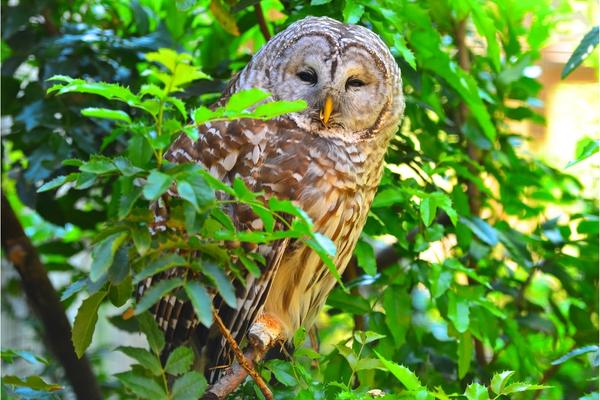The hoot of an owl, a sound synonymous with twilight and the deep woods, possesses an almost preternatural quality. It resonates with a primal echo, captivating human attention across cultures and millennia. But why does this avian vocalization hold such distinctive power? The answer lies not just in the sound itself, but in a confluence of evolutionary adaptations, behavioral imperatives, and acoustic physics.
I. The Laryngeal Labyrinth: Anatomy’s Role in Owl Vocalizations
The syrinx, the avian vocal organ analogous to the mammalian larynx, is the key to understanding the tonal complexity of owl calls. Unlike human vocal cords, the syrinx is located where the trachea bifurcates into the lungs. Owls, in particular, have evolved a highly specialized syrinx. Its unique morphology allows for a broader range of frequencies and greater control over sound modulation than many other bird species. The internal structures, including tympaniform membranes and cartilaginous supports, dictate the resonance characteristics of the emitted sound. The size and shape of the owl’s syrinx influence the fundamental frequency of its hoot, contributing to species-specific vocal signatures. Variations in these structures account for the diverse array of owl vocalizations, from the deep baritone of the Great Horned Owl to the higher-pitched tremolo of the Eastern Screech-Owl.
II. Acoustic Camouflage and Sonic Niches
Owls are predominantly nocturnal predators, and their auditory adaptations are intricately linked to their hunting strategies. The distinct hoot plays a vital role in establishing territorial boundaries and attracting mates in low-light conditions. The frequency and amplitude of the call are optimized to travel long distances through dense foliage, minimizing atmospheric attenuation and maximizing the signal-to-noise ratio. Think of it as acoustic camouflage in reverse; instead of concealing their presence, they amplify their sonic signature to overcome environmental obstacles. Furthermore, different owl species occupy specific acoustic niches within their respective habitats. Variations in hoot characteristics prevent interspecific competition and ensure effective communication within their own populations. An owl species can coexist within a habitat of multiple other species by developing a distinct vocalization that allows them to have their territory and attract their own mates without interruption from other species.
III. Behavioral Context and Communication Complexity
The hoot is far from a monotonous utterance; it is a complex form of communication modulated by behavioral context. Different hoot patterns convey a range of information, including territorial claims, mating calls, alarm signals, and even individual recognition. The duration, frequency, and intensity of the hoot can be varied to signal different messages. For instance, a drawn-out, low-frequency hoot might indicate a territorial boundary defense, while a series of rapid, high-pitched hoots could signify an immediate threat. Moreover, duetting between mated pairs strengthens pair bonds and coordinates activities such as hunting and chick-rearing. Spectrographic analysis reveals subtle variations in hoot structure that are imperceptible to the human ear but crucial for owl-to-owl communication. These nuanced acoustic cues provide a rich tapestry of information that governs owl social interactions.
IV. The Role of Facial Discs and Sound Localization
While the syrinx produces the hoot, the owl’s facial disc and asymmetrical ear placement are crucial for sound localization. The facial disc, composed of specialized feathers, acts as a parabolic reflector, channeling sound waves towards the ears. The asymmetrical ear placement allows the owl to perceive slight differences in the timing and intensity of sound reaching each ear, enabling precise pinpointing of prey location in three-dimensional space. This auditory acuity is essential for hunting in complete darkness. The ability to discern subtle variations in the hoots of conspecifics also relies on this refined auditory system. The brain processes the binaural cues, allowing owls to differentiate between individual callers and interpret the information conveyed in their vocalizations. In essence, the facial disc and asymmetrical ears act as acoustic antennas, amplifying and directing sound to the auditory processing centers of the brain.
V. Cultural Significance and Human Perception
The owl’s hoot has permeated human cultures for centuries, often imbued with symbolic meanings ranging from wisdom and prophecy to death and the supernatural. In many indigenous cultures, the owl is revered as a messenger or guardian spirit. The nocturnal habits and haunting vocalizations have contributed to the owl’s mystique, making it a potent symbol in folklore and mythology. From a purely perceptual standpoint, the hoot’s unique acoustic properties make it easily distinguishable from other natural sounds. The low-frequency components of the hoot travel long distances and are less susceptible to scattering by vegetation, ensuring its audibility even in noisy environments. The rhythmic and repetitive nature of the hoot can also induce a state of heightened alertness and anticipation in human listeners. The uncanny quality of the sound, combined with its symbolic associations, contributes to its enduring fascination.
VI. Conservation Implications and Acoustic Monitoring
Understanding the intricacies of owl vocalizations is not merely an academic exercise; it has significant implications for conservation efforts. Acoustic monitoring techniques, which involve recording and analyzing owl hoots, are increasingly used to assess population size, track habitat use, and monitor the effects of environmental changes. Changes in hoot frequency, duration, or intensity can indicate stress or habitat degradation. By studying the acoustic behavior of owls, researchers can gain valuable insights into their ecological requirements and develop effective conservation strategies. Furthermore, raising public awareness about the importance of owl vocalizations can foster a greater appreciation for these enigmatic creatures and their crucial role in maintaining ecosystem health. The hoot, therefore, serves as both a symbol of wildness and a vital tool for its preservation.
